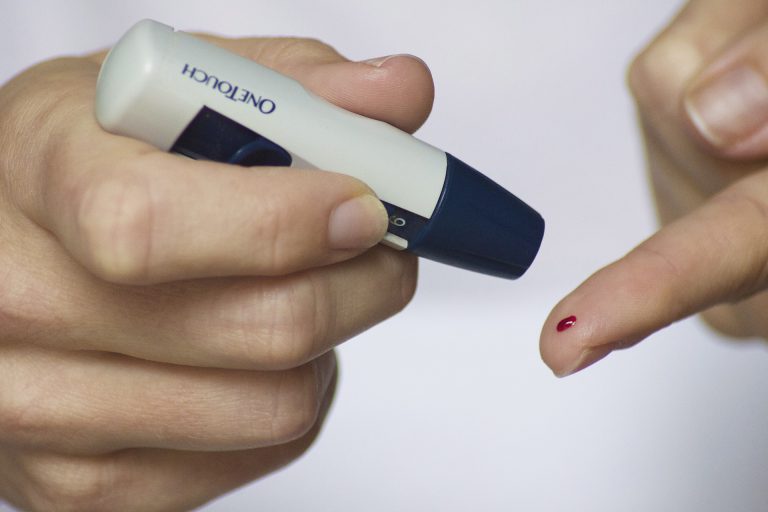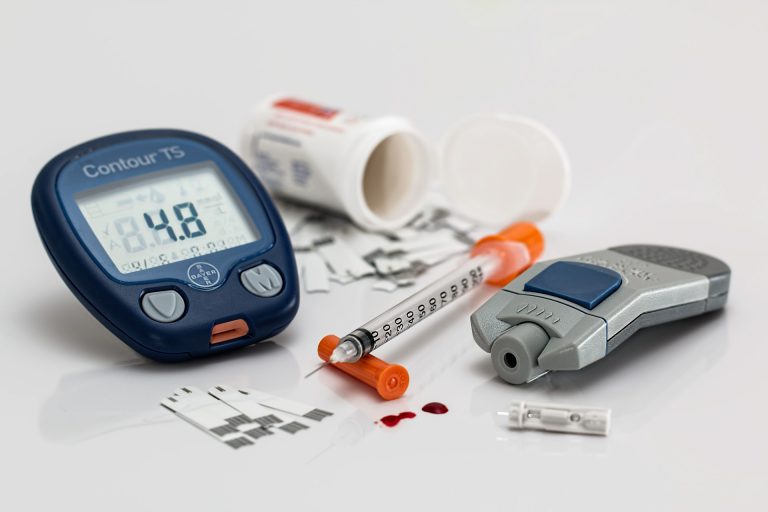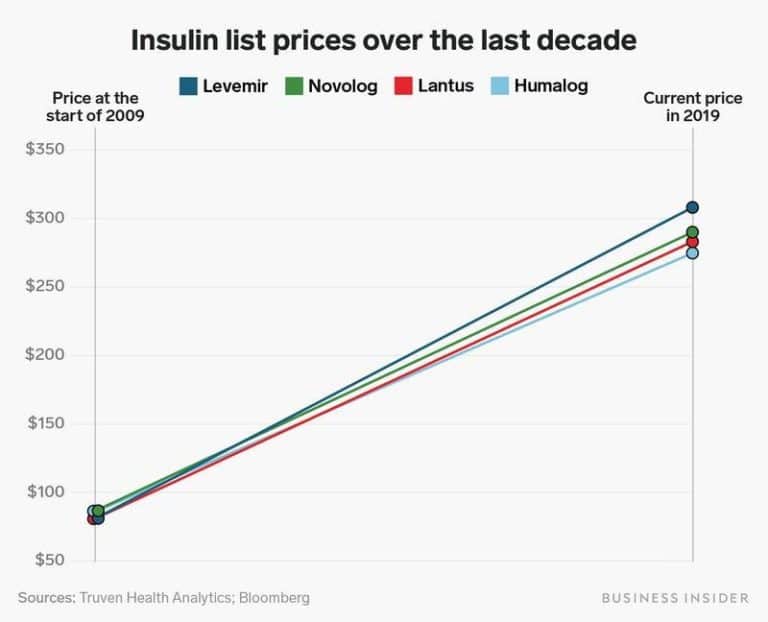Can You Use Expired Diabetes Test Strips?
Regular monitoring of blood glucose levels is an essential part of good diabetes care. Keeping an eye on your blood sugar levels helps you make decisions, in collaboration with your healthcare team, about nutrition, physical activities, and when to take your medications. These are all important decisions that can delay or prevent diabetes complications such as heart attack, blindness, and amputation.
In previous blogs we covered various methods to monitor glucose levels, including continuous glucose monitoring devices but also emerging technologies like using saliva as a pain-free and cheaper alternative to blood for monitoring diabetes, measuring glucose in your tears and using a smart-patch.
Diabetes test strips for blood glucose monitoring
One of the more common ways of monitoring blood glucose levels is using diabetes test strips. These are small disposable strips made of plastic that pack a lot of technology into a small space. They may look insignificant but play in fact a crucial role in good diabetes care for millions around the world.
But how does it work in practice? First, you put a test strip into your blood glucose meter and prick your fingertip with the meter’s tiny needle, which is called a lancet. Then, you squeeze out a droplet of blood and place it onto the glucose strip. Below you can see an instructional video on how to test your blood glucose.
The test strips are coated with a thin layer of gold that is cut into a pattern, which becomes the strip’s circuit. On one end of the strip, there’s a chemical called glucose oxidase that produces gluconic acid from the glucose in the blood. So, when blood is placed onto the test strip, it soaks up your blood like a sponge, reacts with the chemical, and turns the glucose into electricity.
At the other end of the test strip, the meter transfers a current to the test strip, which has electric terminals that allow the meter to measure blood glucose levels. A number appears on the meter that reflects the speed of the electric current – the more blood sugar is detected the stronger the signal, which means a higher number on your blood glucose meter.
How long does a diabetes test strip last?
What about the lifespan of these blood glucose test strips? For years, it has been debated whether people with diabetes can safely use expired test strips. Some claim that the test strips can be used for a short period of time beyond their expiration date if the test strips have been stored properly and any damage to the strips has been avoided. However, this could lead to an inaccurate reading of the blood glucose.
Can expired test strips give a false reading?
The US Food and Drug Administration (FDA) even specifically warns against using expired diabetes test strips as they might lead to inaccurate results. Most experts maintain that the test strips should be used before the expiration date, which should be found on the strips or the box, in which they arrived. After opening, blood glucose test strips can normally be used for three to six months but for this it’s important to refer to the information provided for each brand of test strips.
Accuracy is key when testing your blood sugar. Before considering using expired test strips, it is vital to ask yourself a few questions about their potential effectiveness. This includes how they have been stored, or have they been exposed to dampness or high humidity levels. It is also crucial to take into account how long after the expiration date they can be safely used, and which are the potential risks of using expired test strips.
Do expired glucose test strips read high or low?
One of the reasons why most diabetic patients do not hesitate to use expired test strips is the belief that they always give a lower value than your actual blood sugar reading. However, this is a misconception. Patients believe that they just need to add a few numbers to the reading provided by the glucometer and that would be the correct reading they would have got if they had used the un-expired strips.
So, they think that as far as the reading with the expired test strip is slightly lower than the normal range, it can be considered to be normal.
And in case, the reading shows a higher value, they perceive it as their blood sugar level is too high for which they need to seek medical advice for the correction of dosages or anti-diabetic drugs. This is why; they continue to use the test strips that are expired.
This false belief can prevent them from adopting healthier dietary and lifestyle habits or even consulting a physician when the reading of the blood sugar test shows a lower range as they perceive it to be a normal range.
However, the fact is that the strips may not always give a slightly lower reading than your actual blood sugar levels. It may show slightly lower, slightly higher, very high, very low, or even normal values of your blood sugar levels.
In short, the expired test strips can work in an unpredictable manner. Hence, it is impossible to know your correct blood sugar levels by adding or subtracting a few numbers to the reading you get using the expired strips.
This suggests that expired glucose test strips can give a high as well as a low reading and hence, should not be used. The chances that it will give you a correct reading is too less making it a highly unreliable way to monitor your diabetes control.
While some glucometers are designed to reject the expired strips, not all of them do so, putting the patients at a risk of having a wrong reading in case they happen to use one.
Moreover, researchers from the U.S. CDC (The Centers for Disease Control and Prevention) have found that the old glucose test strips can also sometimes give inaccurate readings, even when their date of expiration is not over.
So, there is also a mild risk of getting an inaccurate result when the strips are nearing their expiry dates. Most glucometers do not reject the strips that are nearing expiration dates. Hence, it is advisable to check the expiry date of the glucose test strip before use and discard them once their expiry date is near or over.
The use of strips that have expired or are near the expiration date can give a wrong reading, believing which could prevent you from seeking the right treatment for ensuring optimum control over diabetes.
Is it OK to use expired lancets?
Just like the expired test strips, even the use of expired lancets should be avoided to be able to manage your blood sugar levels in a safe and efficient manner. However, the reason may be different.
The use of an expired lancet may not lead to an inaccurate reading as the lancet is needed only to prick your finger to get a drop of blood. However, using an expired lancet (sometimes called drums) might cause an infection at the site of puncture as it might have lost its sterility.
Hence, it is advisable to discard the lancets once their expiry date is over. This is specifically important for diabetic patients as the rise in blood sugar levels can make them vulnerable to develop infections easily. So, the use of expired unsterile lancets may facilitate the entry of infectious organisms into their body putting them at risk of infections. This marks the need to check the expiry date of the lancets before use.
Healthcare professionals also caution against the tendency of diabetic patients to use expired lancets or test strips as a cost-saving measure. The FDA has warned that saving money by using expired or pre-owned lancets and strips may be a highly unsafe practice in the short run as well as the long run.
Doing so can carry a potentially higher risk of serious infections (or even death). Relying on the accuracy of such tests to monitor the blood sugar levels and manage diabetes could also eventually lead them to develop serious complications due to the wrongly perceived higher or lower than the actual readings.
The incorrect reading can cause them to adopt certain measures that may not be suitable for improving their diabetic control. It may also prompt them to change the medications or their dosages, which could further worsen their diabetic control.
So, the complications arising due to the infections or inaccurate readings can only increase the expenses the patients have to bear due to the additional treatments and hospitalization involved to correct them. This is why; it is strictly advisable to avoid using expired lancets and test strips not just to avoid complications but also to save unnecessary healthcare expenditure.

For example; inaccurate readings provided by the use of expired or compromised blood sugar testing strips might trigger a number of health issues like hyperglycemia. Hyperglycemia may trigger a life-threatening condition called diabetic coma or ketoacidosis that develops when the body does not have enough insulin. In these cases, the body is not able to break down or use glucose efficiently for fuel causing the ketone bodies to build up in the blood leading to a medical emergency.
An inaccurate reading might also indicate that the blood sugar levels are within the normal range when they are actually in a much lower range. The low blood sugar level (or hypoglycemia) can be as dangerous as the high blood sugar level and requires immediate treatment. Medical issues linked to untreated lower blood sugar levels include visual disturbances, irregular heart rhythm, loss of consciousness, confusion, and seizures.
The risk of exposure to bloodborne pathogens like HIV and hepatitis C is also a possibility that needs to be prevented by avoiding the use of expired lancets.
How does squeezing a finger affect blood sugar?
Patients with diabetes are often advised to test their blood sugar level at home using a glucometer. The use of this device involves adding a drop of your blood to the specific part on a test strip inserted into it.
While adding the drop of blood to the test strip, patients have to squeeze the finger slightly to allow the blood to ooze out from the capillaries. However, the pressure exerted on the finger while squeezing should neither be too hard nor too low.
The researchers have found that squeezing the finger with too much pressure might interfere with the accuracy of the test results. One study has revealed that about 5 to 13% of patients are likely to have a significantly inaccurate blood sugar reading due to the variation in the pressure exerted on the finger for squeezing out a drop of blood.
On average, it was found that the blood sugar readings showed a lower than the actual value when people put more pressure on the finger.
This means diabetic patients should avoid squeezing the finger too tightly as this can dilute the sample of blood with the tissue fluid called plasma and thus, increase the chances of a wrong reading or even hemolysis. The squeezing should be mild enough to just let a drop of blood ooze out onto the test strip.
However, once the blood collection step is complete, they can apply firm pressure to the puncture site to stop the oozing of bleeding.
How often are you supposed to change your lancet?
Although most lancets tend to get dull or blunt after being used several times, the difference between the old and a new lancet is often not apparent to the patients as its use involves a quick finger prick with just a drop of blood being withdrawn.
Hence, though it is a good idea to change the lancet once every day, most diabetics do not experience any issue with changing it after 1 or 2 weeks, if they are using it daily, or after using it at least 10 to 12 times.
However, healthcare professionals insist that the lancets must be changed after each finger prick. The FDA has also recommended changing the lancets after each use, particularly if it involves more than one patient. This is especially important for avoiding the risk of infections involved in using the old and blunt ones.
Reusing dull lancets may also lead to callused fingers ad scars. These issues can also make it difficult to test your blood sugar levels at the same puncture site.
Moreover, as lancets get dull after each use, they can also hurt more when used to prick a finger and may also be ineffective for drawing blood. The pain caused due to the use of blunt lancets can prevent diabetes patients from checking their blood sugar levels frequently thus compromising their glycemic control.
The inefficient drawing of the blood, on the other hand, could lead to inaccurate results thus further contributing to improper diabetic control.
These factors emphasize the need to change the lancets after each use, even if they do not appear to be blunt or cause no apparent pain.
Conclusion
While it may be tempting for some to use expired test strips, there’s a great need for caution and it’s important not to underestimate safety concerns. It’s clear that the active ingredients found on the test strips will not last forever. Patients who decide to use expired test strips must assume the risk of inaccurate results, which can have a detrimental impact on their health. Staying on the safe side by only using test strips that have not expired seems to be the best option for good diabetes care and optimal health outcomes.









